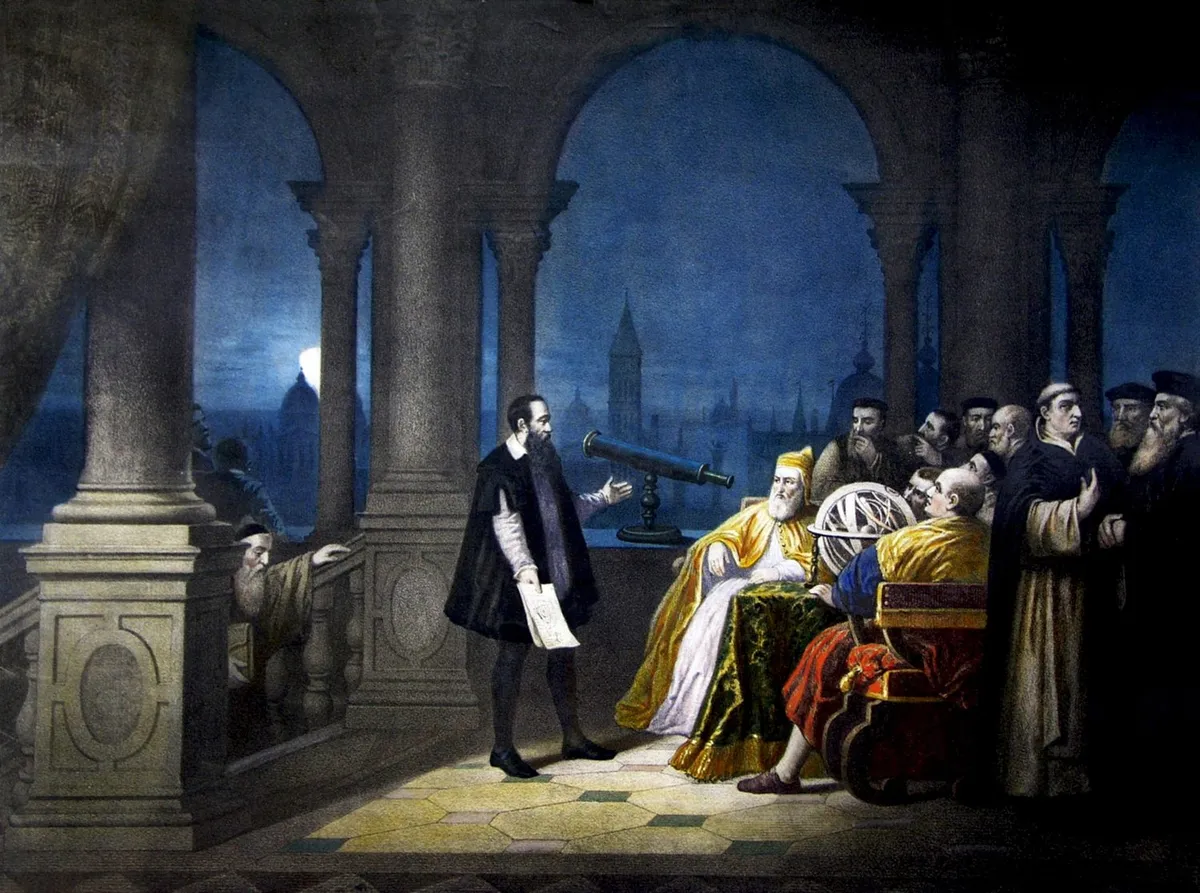The late-16th century astronomer Galileo Galilei is one of the most important figures in astronomy. His study of the laws of motion and astronomical observations through a telescope make him one of the key thinkers in the history science.
Galileo's biggest contribution to astronomy is perhaps his work advocating that Earth and the planets of the Solar System orbit the Sun rather than the other way round, which was the accepted wisdom of his time.
While Galileo had not conceived of the idea himself, he was a major proponent of this heliocentric view of the Solar System, and consequently found himself in trouble with the political and religious establishment of the day.
He was eventually brought before the Inquisition and ordered to recant his theories regarding Earth and its movement around the Sun.
A book by William R. Shea entitled Conversations with Galileo imagines a series of interviews with the famed astronomer discussing his life, his work and how he came to find himself under house arrest.
Below is an extract from the book in which Galileo explores the notion of a heliocentric Solar System.

The idea that the Earth is moving through space eventually transformed our conception of the universe and of our relation to it.
But Copernicus had suggested this only in an effort to improve the techniques used in predicting the astronomical positions of celestial bodies, and he had spent little time trying to prove that it was not only astronomically useful but also physically true.
Galileo addressed these issues, and if he was unable to demonstrate that the Earth both rotates on its axis and revolves around the Sun, he devised brilliant strategies to show that the traditional geocentric arguments were weak and usually smuggled in the assumption that the Earth is at rest.
I suppose the theory that Earth moves was an inspired guess. How did you come to advocate it in the first place?
Galileo: I heard about it for the first time when I was a student at the University of Pisa. One of my teachers poked fun at the whole idea but in such a way that I suspected that he hadn’t understood it.
So I went to the library to have a look at Copernicus’s On the Revolutions of the Heavenly Spheres, and I discovered that it wasn’t a newfangled idea but one that had been put forward in antiquity by Aristarchus of Samos and by some philosophers who were called Pythagoreans after the leader of their school.
I’ve always been amazed at how much the Greeks knew. Think of Archimedes, who was one of the greatest minds of all times, and knew more mathematics than any living person nowadays.
Unfortunately, the arguments of the Ancients for the motion of the Earth were lost, but Copernicus reconstructed them with dogged persistence.
His work was greatly praised and he was even allowed to dedicate his book to Pope Paul III.
But wasn’t that an unsettling idea? After all, we don’t feel the Earth moving.
That’s just what my teachers said – “Use a bit of common sense! If the Earth was turning around very fast, the clouds would fly off.”
I admit this is a real difficulty. Could the Earth be spinning upon itself without any obvious sign that it is doing so?
I was bothered by this until I thought of an experiment that helped me see that motion is relative. Let me try to explain.
Imagine that we both decide to travel from Venice to Egypt by boat, and that when we arrive at the harbour we’re assigned an inside cabin without a porthole.
We are exhausted and we drop on to our bunks and sleep soundly until morning. When we awake, we ask ourselves whether the ship has lifted anchor. It doesn’t seem to move, but this is no conclusive proof that we’re still at rest in the harbour.
After all, we might be sailing so smoothly that we don’t feel anything. How can we find out?
Well, how about going about this scientifically and making some experiments inside our cabin? I light a match and the smoke goes straight up; you throw a ball towards the ceiling and it falls straight down.
We then toss the ball to each other and it moves with the same speed whether it’s thrown towards the front or the back of the ship.
So, as far as we can see, bodies that are put in motion inside the cabin behave as if the ship were at rest.
Perhaps the captain decided not to sail and we really are at rest, but we can’t really know this without going on deck and looking at the shore.
Motion inside a closed cabin is relative. What if motion on the whole surface of the Earth was also relative and undetectable?

Would you want to say that the outcome of these experiments would be the same if they were performed inside a carriage at rest and then in a carriage in motion provided the road was perfectly level and smooth?
Absolutely – but unfortunately such good carriages and such ideal roads have yet to be invented, and to understand how the world really works we have to use our imagination as well as our eyes.
Your argument is striking, but what if someone objected that it shows only that the Earth can move around the Sun, not that it actually does?
What was needed to confirm the hypothesis that the Earth moves was something that happens not in the heavens above but here below on Earth – in other words, a terrestrial argument.
I believe that just that evidence is provided by the tides, for if the Earth was at rest there would be no way of accounting for them.
I know that some people have spoken of the dominion of the Moon over the waters, but that’s just folklore.
I’m surprised that the great Kepler, with his free and acute mind, should have indulged in such fantasies.
However, if the Earth both spins about its axis and revolves around the Sun, then the ebb and the flow of the seas follows necessarily.
The combined motions of the Earth produce a high tide and a low tide at regular intervals.
I even discovered a suitable model.
One day I took a barge carrying fresh water from the mainland to Venice and I noticed that when it accelerated, the water piled up at the back, and when it slowed down, the water still maintained its own motion and rushed to the front.
Now think of seabeds as huge barges where slowing down and speeding up are provided by the two motions of the Earth, one around its axis and the other around the Sun, which are alternately added or subtracted.
This is the simple mechanism that sets the water sloshing backwards and forwards.
Needless to say, the uneven depth and configuration of the seabeds would have to be taken into consideration as well as the varying contour of the shore, but the underlying mechanism is the one I’ve just indicated.
Taken from Conversations with Galileo. Text copyright © William Shea, Watkins Media 2019.
